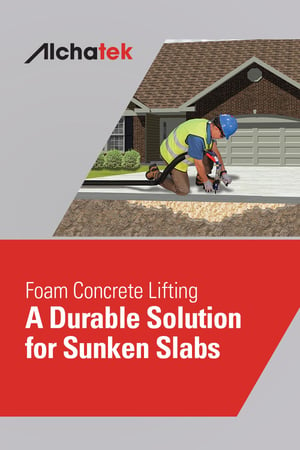
 The Jack Attack and the PolyBadger are practical tools designed to adjust and level concrete surfaces. These concrete lifting devices enhance the efficiency of slab lifting tasks, making them suitable for a wide range of situations. Their user-friendly features efficiently streamline the concrete lifting process.
The Jack Attack and the PolyBadger are practical tools designed to adjust and level concrete surfaces. These concrete lifting devices enhance the efficiency of slab lifting tasks, making them suitable for a wide range of situations. Their user-friendly features efficiently streamline the concrete lifting process.
Jack Attack Leverage Device
The Jack Attack features a triangular steel frame to leverage small to medium-sized slabs while lifting or stabilizing with polyurethane. An integrated 8,000-pound jack applies force to rotate and level the slab. This user-friendly device is easy for one person to operate.
PolyBadger Mobile Lifting System
The PolyBadger offers a cost-effective alternative to conventional 20-foot polyurethane slab lifting trailer rigs. Its setup is straightforward, requiring minimal equipment. The entire system is remarkably compact, fitting effortlessly into the back of a pickup truck, making it a convenient and practical choice.
Simplified Material Handling
The PolyBadger avoids the need to handle and dispose of the large 50-gallon drums typically used in polyurethane slab lifting. Instead, it uses smaller, disposable 10-gallon sets that are easier to manage.
Enhancing Productivity
Featuring few moving parts, the PolyBadger reduces maintenance needs and downtime, thereby increasing job site productivity. Its straightforward design simplifies use compared to other systems.
Concrete Slab Lifting Devices
The Jack Attack System and the PolyBadger enhance the efficiency and outcomes of concrete lifting tasks. These tools streamline operations and ensure smooth, professional results.



 Does leaking or sunken concrete plague your basement floor? These issues can be more than just a nuisance; they can lead to serious structural problems if left untreated. In this article, we'll explore two effective methods for basement floor repair: curtain grouting for leaks and slab lifting for sunken concrete. With an understanding of these techniques, you'll be equipped to find the right repair professionals to restore a safe, dry, and level basement floor.
Does leaking or sunken concrete plague your basement floor? These issues can be more than just a nuisance; they can lead to serious structural problems if left untreated. In this article, we'll explore two effective methods for basement floor repair: curtain grouting for leaks and slab lifting for sunken concrete. With an understanding of these techniques, you'll be equipped to find the right repair professionals to restore a safe, dry, and level basement floor.

 Many homeowners notice over time that their concrete patios may begin to sink or become uneven. Not only does this create an unsightly appearance, but it also poses tripping hazards and potential for accidents. Concrete patio leveling using polyurethane foam offers a precise, durable, and cost-effective solution compared to traditional methods like complete replacement.
Many homeowners notice over time that their concrete patios may begin to sink or become uneven. Not only does this create an unsightly appearance, but it also poses tripping hazards and potential for accidents. Concrete patio leveling using polyurethane foam offers a precise, durable, and cost-effective solution compared to traditional methods like complete replacement.
 A pool deck provides the perfect place to relax and enjoy the summer sun. However, an uneven deck can be unsightly and dangerous. This article explains the causes of settling and an advanced pool deck leveling technique using durable, eco-friendly polyurethane.
A pool deck provides the perfect place to relax and enjoy the summer sun. However, an uneven deck can be unsightly and dangerous. This article explains the causes of settling and an advanced pool deck leveling technique using durable, eco-friendly polyurethane.
 Uneven concrete slabs are a common problem for homeowners. Level concrete slabs are ideal. Not only do sunken slabs look unsightly, but they can also pose safety hazards. However, there's no need to worry. In this post, we'll explore why slabs sink and how polyurethane foam can effectively level them.
Uneven concrete slabs are a common problem for homeowners. Level concrete slabs are ideal. Not only do sunken slabs look unsightly, but they can also pose safety hazards. However, there's no need to worry. In this post, we'll explore why slabs sink and how polyurethane foam can effectively level them.
 When it comes to fixing sunken or uneven concrete slabs, homeowners have two main options: slab jacking with polyurethane and mudjacking (lifting with cement slurry). Both methods aim to level the slab without demolishing or replacing it. However, they differ in their approach and effectiveness.
When it comes to fixing sunken or uneven concrete slabs, homeowners have two main options: slab jacking with polyurethane and mudjacking (lifting with cement slurry). Both methods aim to level the slab without demolishing or replacing it. However, they differ in their approach and effectiveness.
 Sunken concrete slabs plague many property owners. Over time, erosion, shifting soil, compaction, and other factors lead to concrete settlement. As a result, neglecting this issue can cause structural damage, vehicle damage, trip hazards, and other liability risks. However, contractors skilled in leveling concrete with foam offer an efficient and effective solution.
Sunken concrete slabs plague many property owners. Over time, erosion, shifting soil, compaction, and other factors lead to concrete settlement. As a result, neglecting this issue can cause structural damage, vehicle damage, trip hazards, and other liability risks. However, contractors skilled in leveling concrete with foam offer an efficient and effective solution.
 If you've noticed that your driveways, patios, or sidewalks have sunken slabs, it's time to consider a reliable solution: foam concrete lifting. This innovative technique involves pumping a lightweight, yet strong, material beneath the slab to level it out. This article explores the benefits of foam concrete lifting and why it's a great option for homeowners.
If you've noticed that your driveways, patios, or sidewalks have sunken slabs, it's time to consider a reliable solution: foam concrete lifting. This innovative technique involves pumping a lightweight, yet strong, material beneath the slab to level it out. This article explores the benefits of foam concrete lifting and why it's a great option for homeowners.
 As a homeowner, you've probably seen sunken or uneven concrete slabs around your property. Not only are they unsightly, but they can also be dangerous trip hazards. Moreover, this problem can affect many areas, including:
As a homeowner, you've probably seen sunken or uneven concrete slabs around your property. Not only are they unsightly, but they can also be dangerous trip hazards. Moreover, this problem can affect many areas, including:
 Do you have sinking or uneven concrete slabs around your home? Not only can they be an eyesore, but uneven walkways, driveways, and patios can also create tripping hazards and lead to costly accidents. Many homeowners assume their only option is to rip out the old concrete and pour new slabs. However, professional slab lifting offers a much better solution. Lifting concrete is a precise, permanent fix without the chaos and cost of ripping out and replacing old slabs. Keep reading to discover why slab lifting with polyurethane foam is the smart choice.
Do you have sinking or uneven concrete slabs around your home? Not only can they be an eyesore, but uneven walkways, driveways, and patios can also create tripping hazards and lead to costly accidents. Many homeowners assume their only option is to rip out the old concrete and pour new slabs. However, professional slab lifting offers a much better solution. Lifting concrete is a precise, permanent fix without the chaos and cost of ripping out and replacing old slabs. Keep reading to discover why slab lifting with polyurethane foam is the smart choice.